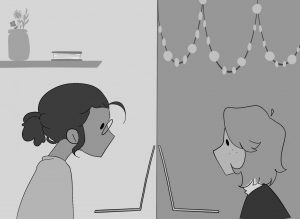DISTANCE LEARNING: Students and teachers reflect on the first semester of distance learning: STUDENTS
February 19, 2021
Every weekday morning, students wake up to the light of their computer screens and take a seat in their virtual classrooms. As SCHS students enter their second semester of school online, some are reflecting on the difficulties they faced during the first semester and are evaluating new changes.
The first day of the new school year started off on an exciting note for many students, like senior Stephanas Avila, who had a positive experience at the beginning of distance learning.
“It went pretty smooth most of the time,” Avila said. “A lot of the students were participating. We were kind of excited to see each other back even though it was through a virtual setting.”
Many teachers worked out the logistics of online instruction in the first semester, but some resources they relied on during in-person learning were difficult to revive. Avila said she has had trouble getting help.
“I would sign up for student support hours, but I would see other students also sign up for that, and they would have little slots and it would be all taken up,” Avila said. “If there was an available time, it would already be too late because it would be like a day after the test.”
Avila added that the disconnect between her and the other students in her classes made it troublesome to reach out to others. Even in breakout rooms, she experienced difficulty when attempting to ask her peers clarifying questions.
Some students, such as sophomore Yenith Cuevas Blancas, found their online classes less engaging as the months passed.
“My experience with online school last year was sort of like a roller coaster. I first was excited because I got to be home and be relaxed, but then the deeper we got into the semester, the more work started to pile up,” Blancas said. “Over the months, I’ve started to realize that my motivation to pay attention in class started to fade.”
The growing lack of student engagement during distance learning was a problem that many teachers faced and hoped to resolve second semester. Some now require students to have their cameras on as part of their grade, while others picked up the rigor in their coursework. Avila understands her teachers’ positive intents but expressed how such changes have resulted in more stress for students.
“They’ve been giving more assignments so that they can keep their students engaged, which keeps you more alert,” Avila said. “But at the same time, it’s like, ‘Oh, did I forget about an assignment? Is there a secret assignment that I didn’t do? What’s that due date for that?’”
Students have also noticed that some teachers are less effective virtually.
“I like online learning better for hard classes, but some teachers are better in-person, like (String) Orchestra and calculus class, so that my teachers can teach better with a whiteboard instead of having to write slowly on Jamboard,” senior Justin Whang said. “We just have to be patient.”
Whang, however, enjoys some recent changes to online classes, such as Google Meet’s breakout rooms.
“The access to breakout rooms is more convenient where our teachers decide to put us in random groups,” Whang said. “In that way, I can meet other people. It’s also better than having to open another tab.”
As students return from winter break, many anticipate positive changes in both their classes and their daily habits for a better-adjusted second semester.
“I hope for the second semester that there can be maybe more self-paced classes,” Blancas said. “And I hope for more self-care days when we have a day off and relax from school.”


